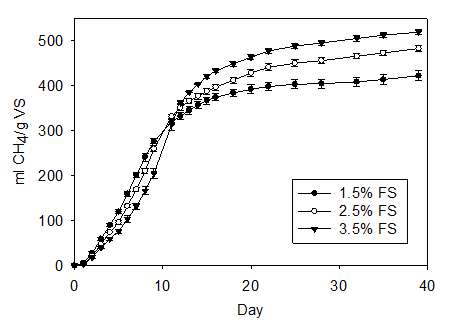ANAEROBIC DIGESTION OF SLUDGE FROM RECIRCULATING AQUACULTURE SYSTEMS: IMPACT OF SOLIDS CONCENTRATION ON METHANE PRODUCTION
Recirculating aquaculture systems (RAS) are efficient at solid waste capture and collection, though the concentrated waste stream still requires disposal, often at a high cost to the farmer. One potential treatment option may be anaerobic digestion, a microbial process occurring in the absence of oxygen, which reduces organic matter. Anaerobic digestion also produces a mixture of methane (CH4) and carbon dioxide gases, collectively known as biogas. Turning waste into value, the biogas can then be captured and used to generate electricity. Increasing the amount of organic matter in the feedstock can result in higher biogas production, but it may also lead to process failure due to excess acid production. In this study, the effect of varying total solids (TS) concentration from fish sludge (FS) on biogas production was evaluated using a biochemical methane potential test. The three treatments consisted of different initial TS concentrations (1.5% FS, 2.5% FS, and 3.5% FS) from a mixture of salmon and trout sludge generated at the Freshwater Institute RAS facility. Methane production was measured, quantified, and normalized on a volatile solids (VS) basis. The three treatments were significantly different, with the 1.5% FS, 2.5% FS, and 3.5% FS producing 422 ± 11 mL CH4/g VS, 483 ± 6 mL CH4/g VS, and 519 ± 5 mL CH4/g VS, respectively. The 1.5% FS treatment reached peak CH4 production on Day 7 (78.2 mL/day), while the 3.5% FS treatment had a peak CH4 production on Day 11 of 96 mL/day. This study demonstrated that RAS sludge is a valuable feedstock for anaerobic digestion, even at higher organic loads.
